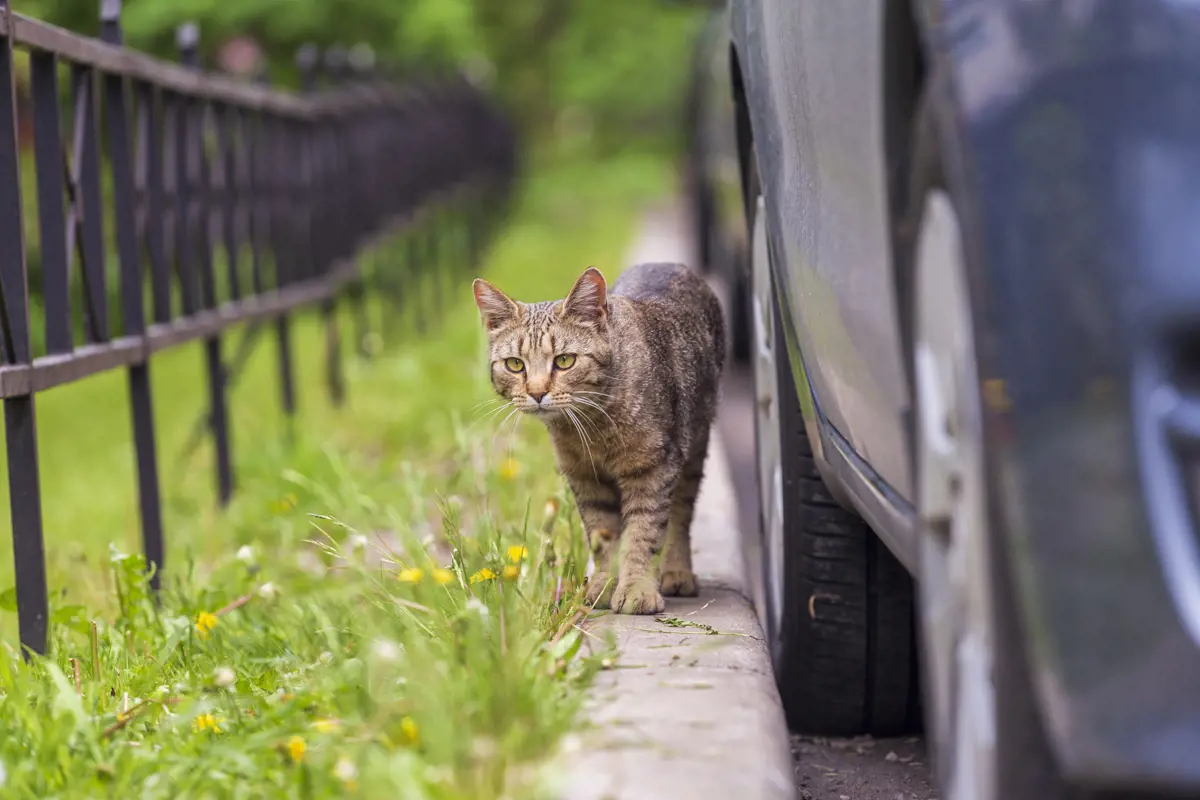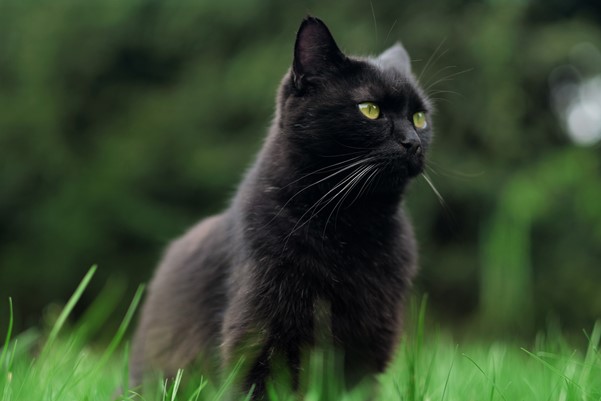How to keep your cat safe if you live near a busy road
9th December, 2020

Being hit by a car is sadly a very common occurrence for our four-legged friends. Such road accidents often result in the need for costly emergency veterinary treatment.
Having adequate cat insurance in place is the best way to get your cat the help it needs if the worst should happen. However, what can you do to prevent such accidents in the first place and are all cats equally prone to such disasters?
If you and your cat live near a busy road, you’ll need to know the answers to these questions sooner rather than later.
Are all cats at risk from busy roads?
Any outdoor cat could be at risk of having an accident while outside the home. From predators and territorial disputes to viruses and road accidents, there are many perils out there that our kitties have to avoid.
However, research has found some cats are indeed more at risk than others. According to the Royal Veterinary College a cat is more likely to be hit by a car if they’re young, male and crossbred. But that doesn’t mean that an older female Persian is immune to danger!
The Royal Veterinary College research found that younger cats, aged six months to six years, are at the greatest risk. This is due to the fact they have less experience of the outside world and might be more prone to roaming far from home looking for potential mates.
Likewise, male cats (especially unneutered ones) are 1.3 times more at risk than female cats, while crossbred cats are 1.9 times more at risk of road traffic accidents compared to purebred cats. #
Something to be aware of when weighing the risks of allowing your kitty the opportunity to roam free!
In terms of most dangerous times of the year, autumn is the likeliest time for cats to be involved in a road traffic accident.
As the days grow shorter, cats will inevitably spend more time outside in the dark so it’s important to take precautions at this time of year. However, the research also showed they are less at risk in winter as compared to spring.
But it’s not just moving cars that can be a danger to your cherished cat. Stationary cars can also pose a significant threat.
Whether trying to stay dry from the rain or stay cool from the summer sun, cats often hide underneath parked cars. When cars are moved, this can result in serious traumatic injuries.
In the colder months, they’ve even been known to crawl into an engine compartment or a wheel arch to seek out warmth. To guard against this danger always check under the car or bang on the bonnet before driving off. Doing so might just save a cat’s life!
Despite popular belief cats don’t have nine lives, and they don’t have much awareness when it comes to roads. The noise, smell and size of cars should be a natural deterrent to a cat but this is not always the case.
After all, a cat that has lived the majority of its life near a busy road may have grown used to cars. Without that fear or wariness such a cat might be less cautious when crossing streets or sitting in driveways.

Tips and tricks to reduce road risks
The most obvious answer to the problem of a nearby busy road is to keep a cat indoors. While this might be a solution for some cats, others enjoy nothing more than being in the great outdoors. Trying to keep such a cat inside permanently can create welfare issues that you need to consider.
Owners of indoor cats need to provide plenty of physical and mental enrichment. Scratching and climbing posts and toys will let them behave naturally by climbing, hiding, pouncing and hunting, while also saving your furniture from damage!
Providing your previously outdoor cat with the same quality of life as an indoor cat could prove to be impossible and unfair on you both.
However, there are things you can do to help your outdoor wanderer stay safe around roads:
-
Neuter your cat. If you haven’t done this already, it’s something worth considering. Neutered cats are much less likely to roam far from home in search of a mate. As an added advantage for male cats it will also mean they’re less likely to get into fights and come to harm. While for females it will stop unwanted pregnancies.
-
Keep cats indoors at night. Only letting your cat out during daytime might be a way of getting the best of both indoor and outdoor worlds. To achieve this try feeding your cat as the sun goes down. Your cat will soon realise the new schedule and will head for home around this time. That way you can shut them in ready for the night. If you live near a road with a morning and evening rush hour, try to keep your cat in during these times.
-
Fit a reflective collar. Just as cyclists and road workers wear high-vis clothing to keep them safe, so should your cat. A reflective collar will help drivers spot your kitty in the dark or in poor light conditions, giving them vital time to brake if necessary. If you add a little bell it could also help cut down on your cat’s impact on the local bird life. A word of warning, cats have been injured by collars becoming caught on a fence, branch or other object while they’re out exploring. To avoid this, invest in a break-away style collar, which will open if your cat catches it.
-
Provide a secure outside area. If you don’t like the idea of keeping your cat indoors, consider creating a secure outside space away from the busy road. Remember that cats have startling acrobatic skills so it might be worth investing in specialist fencing to make it harder for them to escape.
-
Invest in a harness. Dogs aren’t the only pet you can take for a walk. Investing in a cat harness is becoming a popular way to safely walk cats outdoors. It also offers vital mental and physical enrichment for indoor cats. However, not every cat will accept a harness, particularly if they didn’t wear a harness when they were younger. And be aware that walking a cat isn’t quite the same as walking a dog. Dogs aren’t as likely to race up a tree, for example!
-
Arrange cat insurance. Hopefully it will never happen but your cat could be involved in a road traffic accident. By arranging the best cat insurance within your budget, you won’t need to worry about the costs of emergency veterinary treatment – leaving you time to focus on your feline’s recovery.
-
Have your cat microchipped. If you get your cat microchipped you’ll be more likely to be reunited with them if something happens. Importantly if your cat is injured and is taken to a vet then they can quickly contact you. This could make a big difference to the care your cat receives. If you have cat insurance and your vet can contact you easily, then you are more likely to arrange suitable treatment.
If you have a cat insurance policy with Purely Pets then call our 24-Hour Vet Helpline for help and advice.

A rehoming alternative
If none of these options is viable and the road is simply too dangerous, then it might be the time to consider other options such as rehoming.
Rehoming a cat is a big responsibility and crucial to your cat’s future happiness and wellbeing. Giving a cat away for free should be avoided at all costs. There are too many awful stories where animal abusers or people involved in illegal dog-fighting have obtained cats in this way.
Finding your cat a new home with a trusted friend, relative or work colleague could be a good option. However, it’s your responsibility to find out if they are serious about becoming owners.
Are they prepared for ongoing costs such as food and vet bills? Do they realise it's a long-term commitment or are they just adopting on a whim?
The best route is probably through a rehoming or rescue charity. In the UK there are around 1,300 shelters, cat rescue centres, rehoming organisations, and independent rescue groups to choose from. So there will be more than one that covers your area. Find rescue and rehoming organisations near you to get started.
What to do if you’re involved in an accident
Whether a cat can survive being hit by a car depends on the severity of its injuries and how quickly treatment is sought. Important factors include:
-
Speed of the car on impact
-
How the cat is hit
-
Type of car
-
Prior health of the cat
Cats that are run over by a car will suffer widespread internal injuries resulting in almost instantaneous death. Whereas a cat that suffers a glancing blow from a car may suffer multiple fractures, but can survive with appropriate and quick treatment.
If a cat suffers abdominal or spinal injuries they are more likely to die, as are those that present with an increasing number of injuries.
While there is no legal duty to stop and report an accident involving a cat, as pet lovers our advice for drivers is:
-
Stop – If it is safe to do so then stop and see if you can help. The cat might just be injured and there could be a chance to save its life.
-
Help – Whether the cat is injured or dead, take it to the nearest veterinary surgery. Any vet will provide emergency care to a cat in need, at no cost to you.
-
Report – If the cat has been killed, ask locally to see if anyone knows the owner. If you have no luck then the local vet may be able to locate the owner if the cat has been microchipped.

What to do if your cat gets run over
If you actually witness the accident, you’ll be able to whisk your cat to the vets immediately.
Realistically your cat may well have suffered severe injuries such as bleeding, broken bones, damage to internal organs or a head injury. Doing the following will give them the best chance of survival:
-
Immediately contact your vet and warn them you’re bringing in an injured cat.
-
Assess how bad the injuries are. The more information you can give your vet the better.
-
Is CPR necessary? If you’re confident to do this then it could give your vet more time to save your pet’s life.
-
Apply pressure over any wound to stop bleeding.
-
Move the animal carefully, wrapped in a blanket or towel, to prevent further injury.
-
Get them to the vet as soon as possible. Every second counts in a medical emergency.
-
Contact your cat insurance provider. We’re here to help in any emergency.
Get a cat insurance quote from Purely Pets
From minor to serious injuries, it’s important your wonderful companion receives the very best care available. The team at Purely Pets will work tirelessly to get you the best cover to suit your budget and your cat’s particular needs.
Whatever life throws at you, if you’ve taken out award-winning cat insurance arranged through Purely Pets you’ll get cover for vet fees from £1,000 to £15,000 per year. You can even choose an excess level starting from just £60.
Our team of insurance specialists have designed 15 levels of lifetime cover to give you the freedom to decide what’s best for you and your cat. Our cover can include complementary treatments, special diets and even the costs of advertising and reward if your treasured tabby goes missing.
We also offer a 24-Hour Vet Helpline staffed by veterinary professionals, so you can get advice, reassurance, or answers for your feline-related questions at any time. In addition, our online policy management portal gives you ultimate flexibility to manage your policy at a time to suit you.
Purely Pets can provide you with an online quote for your cat within minutes.
Get a quick quote today.
Policy benefits, features and discounts offered may very between insurance schemes or cover selected and are subject to underwriting criteria. Information contained within this article is accurate at the time of publishing but may be subject to change.
Helpful Pages
Recent Posts
Pet Insurance Quote
- 98% claims paid *
- Claims paid directly to vets
- 24/7 vet video consultations
- Interest free monthly payments




